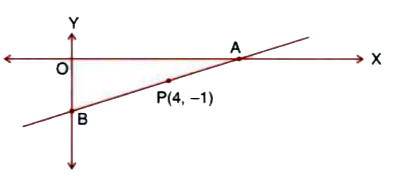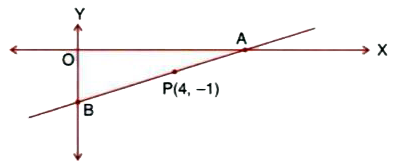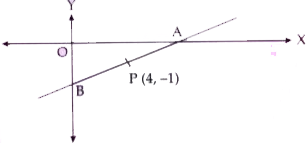The line x+y=1 meets X-axis at A and Y-axis at B,P is the mid-point of AB,P1 is the foot ofperpendicular from P to OA,M1, is that of P1, from OP;P2, is that of M1 from OA,M2, is that of P2, from OP;P3 is that of M2, from OA and so on. If Pn denotes the nth foot of the perpendicular on OA, then find OPn.
To solve the problem step by step, we will follow the instructions provided in the video transcript and break down the solution clearly.
Step 1: Find Points A and B
The line given is x+y=1.
- To find point A (where the line meets the x-axis), set y=0:
x+0=1⟹x=1⟹A(1,0)
- To find point B (where the line meets the y-axis), set x=0:
0+y=1⟹y=1⟹B(0,1)
Step 2: Find Midpoint P of AB
The midpoint P of segment AB can be calculated using the midpoint formula:
P=(x1+x22,y1+y22)=(1+02,0+12)=(12,12)
Step 3: Find P1, the Foot of the Perpendicular from P to OA
The line OA is along the x-axis (y = 0). The foot of the perpendicular from point P to OA (which is the x-axis) will have the same x-coordinate as P and a y-coordinate of 0:
P1=(12,0)
Step 4: Find M1, the Foot of the Perpendicular from P1 to OP
The line OP can be determined by finding the slope of OP. The slope of OP (from O(0,0) to P(1/2, 1/2)) is:
slope of OP=12−012−0=1
The equation of line OP (y = x) can be used to find M1. The foot of the perpendicular from P1 to OP will have the same x-coordinate as P1 and will lie on the line y = x:
M1=(0,0) (since it lies on the line y = x)
Step 5: Find P2, the Foot of the Perpendicular from M1 to OA
Since M1 is at the origin (0,0), the foot of the perpendicular from M1 to OA will again be:
P2=(0,0) (since it lies on the x-axis)
Step 6: Continue the Pattern
Following the same logic:
- P3 will be the foot of the perpendicular from M2 to OA, and since M2 will also be at the origin, P3 will also be (0,0).
- This pattern continues, leading us to conclude that Pn will always be at the origin.
Step 7: Find OP_n
The distance OPn can be expressed as:
OPn=Distance from O(0,0) to Pn
Since Pn converges to the origin, we can express OPn as:
OPn=12n
Final Answer
Thus, the distance OPn is given by:
OPn=12n
The line given is x+y=1.
- To find point A (where the line meets the x-axis), set y=0:
x+0=1⟹x=1⟹A(1,0)
- To find point B (where the line meets the y-axis), set x=0:
0+y=1⟹y=1⟹B(0,1)
The midpoint P of segment AB can be calculated using the midpoint formula:
P=(x1+x22,y1+y22)=(1+02,0+12)=(12,12)
The line OA is along the x-axis (y = 0). The foot of the perpendicular from point P to OA (which is the x-axis) will have the same x-coordinate as P and a y-coordinate of 0:
P1=(12,0)
The line OP can be determined by finding the slope of OP. The slope of OP (from O(0,0) to P(1/2, 1/2)) is:
slope of OP=12−012−0=1
The equation of line OP (y = x) can be used to find M1. The foot of the perpendicular from P1 to OP will have the same x-coordinate as P1 and will lie on the line y = x:
M1=(0,0) (since it lies on the line y = x)
Since M1 is at the origin (0,0), the foot of the perpendicular from M1 to OA will again be:
P2=(0,0) (since it lies on the x-axis)
Following the same logic:
- P3 will be the foot of the perpendicular from M2 to OA, and since M2 will also be at the origin, P3 will also be (0,0).
- This pattern continues, leading us to conclude that Pn will always be at the origin.
The distance OPn can be expressed as:
OPn=Distance from O(0,0) to Pn
Since Pn converges to the origin, we can express OPn as:
OPn=12n
Thus, the distance OPn is given by:
OPn=12n
Topper's Solved these Questions
Similar Questions
A line AB meets X-axis at A and Y-axis at B. P(4,−1) divides AB in the ratio 1:2.

Find the Coordinates of A and B
View SolutionA line AB meets X-axis at A and Y-axis at B. P(4,−1) divides AB in the ratio 1:2.

Find the co-ordinates of A and B.
View SolutionA line AB meets X-axis at A and Y-axis at B. P(4, -1) divides AB in the ratio 1:2.
(i) Find the coordinates of A and B.

View SolutionA line AB meets X-axis at A and Y-axis at B. P(4, -1) divides AB in the ratio 1:2.
(ii) Find the equation of the line through P and perpendicular to AB

View SolutionThe point P (5, 3) was reflected in the origin to get the image P'.
If M is the foot of the perpendicular from P to the x - axis , find the co-ordinates of M.
View SolutionS is the point (0,4) and M is the foot of the perpendicular drawn from a point P to the y-axis. If P moves such that the distance PS and PM remain equal find the locus of P.
View SolutionFind the coordinates of the foot of the perpendicular drawn from the point P(1,-2) on the line y = 2x +1. Also, find the image of P in the line.
View Solutionif P is the length of perpendicular from origin to the line xa+yb=1 then prove that 1a2+1b2=1p2
View SolutionIf the tangent at (1,1) on y2=x(2−x)2 meets the curve again at P, then find coordinates of P.
View SolutionIf P is the pole of chord AB of a parabola dnt he length of perpendiculars from A, P, B on any tangent to the curve be p1,p2andp3, then (A) p3 is the G.M. between P1andp2 (B) p3 is the A.M. between p1andp2 (C) p1 is the G.M. between P1andp3 (D) none of these
View Solution
